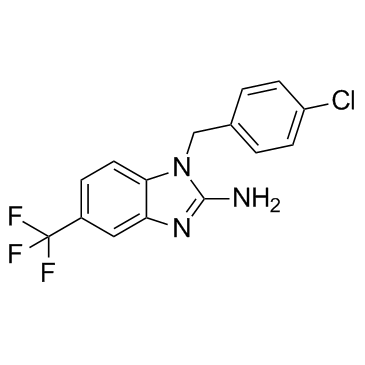NS-638 |
| Catalog No.GC30997 |
NS-638 is a small nonpeptide molecule with Ca2+-channel blocking properties.
Products are for research use only. Not for human use. We do not sell to patients.

Cas No.: 150493-34-8
Sample solution is provided at 25 µL, 10mM.
NS-638 is a small nonpeptide molecule with Ca2+-channel blocking properties. K+-stimulated intracellular Ca2+-elevation is blocked with an IC50 value of 3.4 μM.
NS-638 dose dependently inhibits K+-stimulated [45 Ca2+]-uptake in chick cortical synaptosomes and 2-amino-3-(3-hydroxy-5-methylisoxazol-4-yl)propionic acid (AMPA)- stimulated [3H]GABA-release from cultured cortical neurons with IC50 values of 2.3 and 4.3 μM, respectively. K+-stimulated intracellular Ca2+-elevation in cultured cerebellar granule cells is equipotently blocked with an IC50 value of 3.4 μM. At this concentration no effect on Ca2+-induced contractions in K+-depolarized guinea pig taenia coli is observed. NS-638 reversibly blocks N- and L-type Ca2+-channels in cultured chick dorsal root ganglion cells in the concentration range of 1-30 μM[1].
In the mouse middle cerebral artery occlusion model, NS-638 administered i.p. (50 mg kg-1) at 1 h and 6 h post-ischemia, and once a day for the next two days, results in a 48% reduction in total infarct volume. It does not show protection against ischemic neuronal damage in the gerbil model of bilateral carotid artery occlusion[1].
[1]. M?ller A, et al. Pharmacological profile and anti-ischemic properties of the Ca(2+)-channel blocker NS-638. Neurol Res. 1995 Oct;17(5):353-60.
Cell experiment: | The effect of NS-638 on neuronal Ca2+-channels is evaluated using whole cell patch clamp techniques[1]. |
Animal experiment: | Mice: In the mouse middle cerebral artery occlusion model, NS-638 is administered i.p. (50 mg kg-1) at 1 h and 6 h post-ischemia, and once a day for the next two days[1]. |
References: [1]. Møller A, et al. Pharmacological profile and anti-ischemic properties of the Ca(2+)-channel blocker NS-638. Neurol Res. 1995 Oct;17(5):353-60. | |
| Cas No. | 150493-34-8 | SDF | |
| Canonical SMILES | NC1=NC2=CC(C(F)(F)F)=CC=C2N1CC3=CC=C(Cl)C=C3 | ||
| Formula | C15H11ClF3N3 | M.Wt | 325.72 |
| Solubility | DMSO : ≥ 34 mg/mL (104.38 mM) | Storage | Store at -20°C |
| General tips | Please select the appropriate solvent to prepare the stock solution according to the
solubility of the product in different solvents; once the solution is prepared, please store it in
separate packages to avoid product failure caused by repeated freezing and thawing.Storage method
and period of the stock solution: When stored at -80°C, please use it within 6 months; when stored
at -20°C, please use it within 1 month. To increase solubility, heat the tube to 37°C and then oscillate in an ultrasonic bath for some time. |
||
| Shipping Condition | Evaluation sample solution: shipped with blue ice. All other sizes available: with RT, or with Blue Ice upon request. | ||
| Prepare stock solution | |||

|
1 mg | 5 mg | 10 mg |
| 1 mM | 3.0701 mL | 15.3506 mL | 30.7012 mL |
| 5 mM | 0.614 mL | 3.0701 mL | 6.1402 mL |
| 10 mM | 0.307 mL | 1.5351 mL | 3.0701 mL |
Step 1: Enter information below (Recommended: An additional animal making an allowance for loss during the experiment)
 g
g
 μL
μL

Step 2: Enter the in vivo formulation (This is only the calculator, not formulation. Please contact us first if there is no in vivo formulation at the solubility Section.)
Calculation results:
Working concentration: mg/ml;
Method for preparing DMSO master liquid: mg drug pre-dissolved in μL DMSO ( Master liquid concentration mg/mL, Please contact us first if the concentration exceeds the DMSO solubility of the batch of drug. )
Method for preparing in vivo formulation: Take μL DMSO master liquid, next addμL PEG300, mix and clarify, next addμL Tween 80, mix and clarify, next add μL ddH2O, mix and clarify.
Method for preparing in vivo formulation: Take μL DMSO master liquid, next add μL Corn oil, mix and clarify.
Note: 1. Please make sure the liquid is clear before adding the next solvent.
2. Be sure to add the solvent(s) in order. You must ensure that the solution obtained, in the previous addition, is a clear solution before proceeding to add the next solvent. Physical methods such as vortex, ultrasound or hot water bath can be used to aid dissolving.
3. All of the above co-solvents are available for purchase on the GlpBio website.
Quality Control & SDS
- View current batch:
- Purity: >98.00%
- COA (Certificate Of Analysis)
- SDS (Safety Data Sheet)
- Datasheet
Average Rating: 5 (Based on Reviews and 21 reference(s) in Google Scholar.)
GLPBIO products are for RESEARCH USE ONLY. Please make sure your review or question is research based.
Required fields are marked with *



















